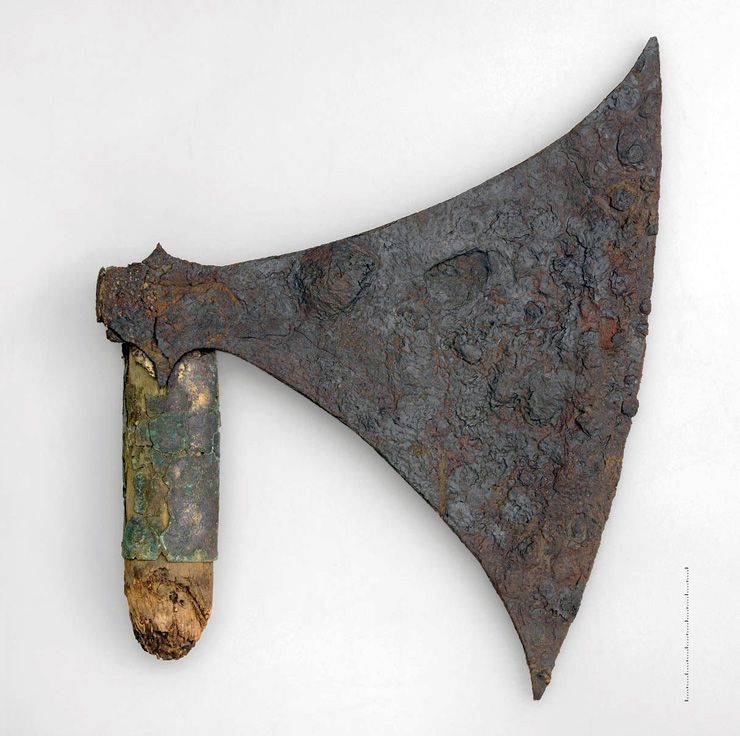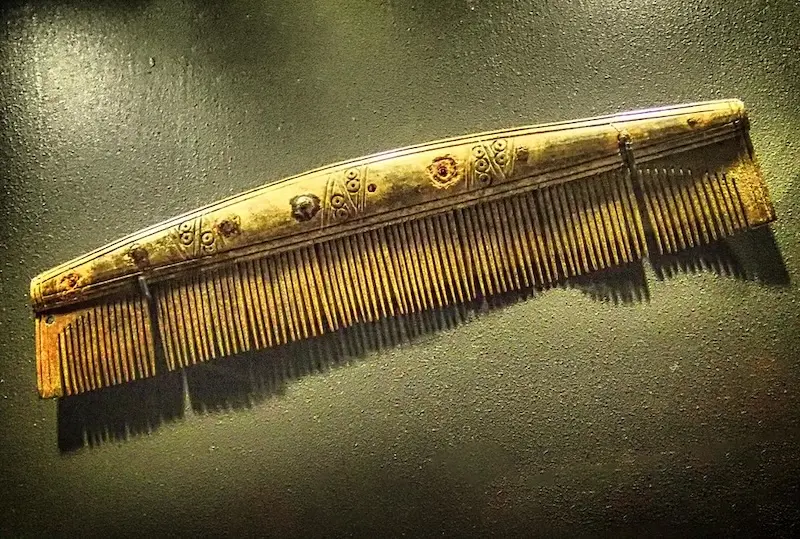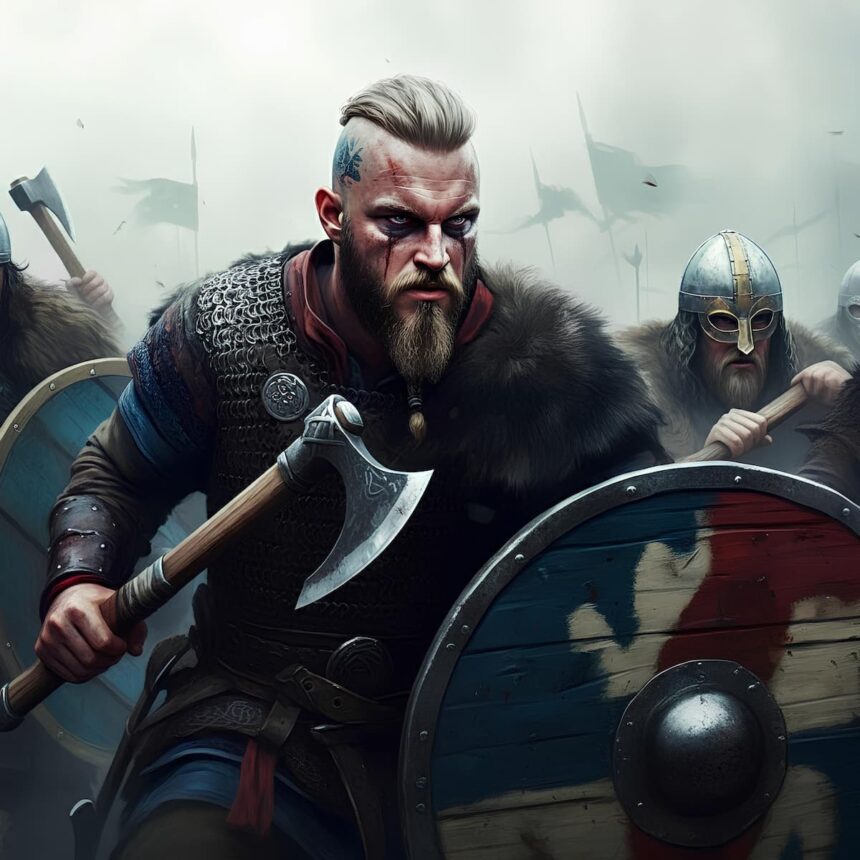Vikings Loved Horned Helmets
The stereotypical image of a Viking resembling a Skyrim character has nothing to do with reality. No sane warrior would wear a helmet with decorative horns. Yes, such headgear existed, but it was ceremonial armor worn during religious rituals or used as a status symbol.
- Vikings Loved Horned Helmets
- The Viking’s Standard Weapon Was a Double-Edged Axe
- Vikings Were a People
- Vikings Were Mighty Redheaded Giants
- Vikings Were Dirty Barbarians
- They Drank Wine from Their Enemies’ Skulls
- Women in Viking Society Enjoyed Equality
- The Vikings’ Favorite Torture Was the “Blood Eagle”
- Ivar the Boneless Was Weak
In battle, a helmet with such an adornment would more likely help the enemy kill you; if a weapon caught on the horn, it could cause serious injury.
Helmets were made smooth so that enemy weapons would glide off them upon impact, increasing the chances of survival. That’s why real Viking helmets, such as the one found in 1943 at the Jermundbu farm in Norway, had no horns. Nor do medieval depictions of Scandinavians show them with horns.
Most likely, the myth of horned Viking helmets was created by costume designer and illustrator Carl Emil Doepler. For the 1876 production of Wagner’s opera Der Ring des Nibelungen (The Ring of the Nibelung), he designed beautiful but unrealistic outfits, including winged and horned helmets.
The Viking’s Standard Weapon Was a Double-Edged Axe

This weapon is very popular in cartoons and games about Vikings. It did exist and was called a labrys. However, one small detail: Vikings didn’t wield them. Labryses were created by weaponsmiths of the Minoan civilization of the Bronze Age.
Later, the Greeks borrowed this axe from the Minoans and made it an attribute of Zeus. Yes, Thor had Mjolnir, and Zeus had the labrys. It was likely not a weapon but a ceremonial item.
If Vikings were given such an axe, they would probably find it very inconvenient and impractical.
Scandinavians used broadaxes—single-edged axes shaped like a crescent—and skeggoxes—bearded axes with a protruding lower blade edge.
These were simple and convenient weapons. They were easier to master than a sword and simpler to maintain.
Moreover, in times of peace or during long journeys, Scandinavian axes were used as tools: chopping wood, shaping boards, or hammering nails into a drakkar. A double-edged axe would hardly be suited for such tasks.
And no, Viking axes were not heavy weapons for true giants. On average, they weighed from 800 grams to 1.5 kilograms. In fact, the most popular Viking weapon wasn’t even the axe, but the spear, as it was much easier to manufacture.
Vikings Were a People
If you think that a Viking was a member of some northern tribe, you’re mistaken. “Viking” wasn’t an ethnicity, but a type of activity.
In Old Norse, the word Víking referred to a raid for plunder or simply an expedition for peaceful purposes—for example, exploration or trade. A Víkingr was someone who participated in such an expedition.
Vikings could be Swedes, Norwegians, or Danes. Other people referred to them by the Latin term Norman—meaning “northerner.” In everyday life, a Viking could engage in any occupation: farming, crafting, agriculture, raising livestock, hunting, or fishing. Such people were called bóndi—free farmers with their own households.
When a Scandinavian lacked means to survive or sought adventure, travel, or military glory, they would join other *bóndi*, and together they would set out on a raid to plunder neighbors, find a better piece of land, or even just trade. Then, they would return home and live as before.
Vikings Were Mighty Redheaded Giants
When you imagine Vikings, you likely picture mighty and tall red-haired barbarians with luxurious mustaches. Or blond handsome warriors like Travis Fimmel. However, real Vikings might disappoint you a bit.
According to archaeological findings, their average height was 172 cm, and Viking women stood around 158 cm—6–10 cm shorter than today’s averages.
Modern Scandinavians are much taller than their ancestors. This is quite natural, as they lived in very harsh conditions, had poorer diets, and shorter lifespans—not the best conditions for athletes and basketball players.
Additionally, the hard physical labor of the northerners led to health problems. Louise Campe Henriksen, curator of the Viking Ship Museum in Roskilde, notes that osteoarthritis and dental diseases were common among Scandinavians of that time.
Norman warriors were also not especially rugged or masculine in appearance.
Here’s what an archaeologist and anthropologist from the University of Copenhagen says:
“In fact, determining the sex of Viking-era skeletons is difficult. Male skulls were slightly more feminine than those of modern people, and female skulls were more masculine.”
Lise Lock Harvig , Department of Forensic Medicine, University of Copenhagen
She adds that Viking women had prominent jaws and developed brow ridges, while the men’s facial features were more feminine. Furthermore, an Arab traveler who visited the city of Hedeby around 1000 AD noted that both Viking women and men wore makeup to appear more attractive.
As for red hair, it wasn’t uncommon among the northerners, but there were plenty of blond, brunette, and light-brown-haired Vikings as well.
And they didn’t wear the drab gray and black clothing like extras in Game of Thrones. The northerners preferred bright and colorful clothes and loved silk and furs. The most popular colors were red and blue.
Vikings Were Dirty Barbarians

No, the Scandinavians had nothing against hygiene. The English, who didn’t particularly like the northern invaders for obvious reasons, seem to have branded them as unwashed savages. In reality, Vikings bathed at least once a week, typically on Saturdays, which was quite good for that time.
In Old Norse, Saturday was called Laugardagur, which translates to “washing day.” Archaeological findings show that Vikings had tweezers, beard combs, tools for cleaning nails and ears, and toothpicks. A chronicler, John of Wallingford, wrote in 1220 that they bathed, changed clothes, and combed their hair, which made them quite popular with English women.
John disapprovingly referred to this hygiene as a “frivolous whim.” These pagans would come up with anything.
Vikings also styled and bleached their hair and used eyeliner. In the later seasons of the TV show Vikings, Ragnar Lothbrok sports a shaved head, and other characters love to flaunt striking hairstyles, shaved in the best Scandinavian barbershops.
However, in reality, Vikings shaved the heads of criminals and slaves, while they themselves wore long hair.
They Drank Wine from Their Enemies’ Skulls
This sounds very brutal, but it is largely a myth.
Throughout history, there are numerous examples of human skulls being turned into various vessels. Scythians, Mongols, Chinese, Europeans, Slavs, and Japanese all did this at some point. It’s quite possible that some Vikings may have also made drinking cups from skulls. However, the practice of making vessels from the skulls of defeated enemies was likely not widespread.
The myth may have originated from a mistranslation by Ole Worm, a Danish physician and naturalist, in his 1651 book Runer seu Danica literatura antiquissima. He incorrectly translated a line from the poem Krákumál.
In Old Norse, the phrase was drekkum bjór af bragði ór bjúgviðum hausa — “drink beer from the curved branches of skulls.” The “curved branches of skulls” is a kenning (a metaphor) for “horn.” Worm, however, translated the line as: “The heroes hoped to drink in Odin’s hall from the skulls of those they killed.” There was no Google Translate back then.
Mostly, Scandinavians made vessels from animal horns, as well as wood and metal.
Women in Viking Society Enjoyed Equality

The internet often claims that Viking women had the same rights as men and even fought alongside them in battles. Such privileges were unthinkable in the 8th–11th centuries when women from other cultures were heavily oppressed. So, were Viking women really that lucky? Not quite.
TV shows like Vikings exaggerate women’s roles in combat. Researcher Judith Jesch from the University of Nottingham argues that brave female warriors existed only in Norse myths, and there is no evidence they existed in reality. Other scholars suggest that female warriors did exist, but they were rare.
Such women were called Skjaldmær — “shield maiden.”
And while Norse women had more freedom than women from other cultures, there was no true equality in Viking society.
For example, the medieval Icelandic legal code Grágás forbade women from wearing men’s clothing, cutting their hair short, or owning weapons. They were also prohibited from participating in most political or governmental activities. Only men could attend the ting, the public assembly of free Norsemen. Women also could not serve as judges or testify in court.
However, Norse women could own property, manage land inherited from their husbands or family, and demand a divorce if their husbands mistreated them. For the Middle Ages, that was already quite progressive. In general, Vikings respected their women, as they managed the household and crops while their husbands were away on expeditions.
The Vikings’ Favorite Torture Was the “Blood Eagle”
This gruesome torture, in which a living person’s back was cut open and their lungs removed, was likely invented by Christian chroniclers who sought to portray the Norsemen as terrifying demons.
Researchers believe that Vikings wouldn’t have devised such a complex surgical procedure.
It’s also too difficult to pull out lungs from a living person: the victim would quickly die from shock and pneumothorax before they had time to suffer.
It’s quite possible that the bloody fantasies about ribs and lungs sticking out of the back were born from a mistranslation of the saga Ragnarssona þáttr, “The Tale of Ragnar’s Sons.” In it, Ivar the Boneless takes revenge on King Ælla II for his father. Vaguely interpreted words about eagles and a torn back may indicate that Ivar simply left Ælla’s corpse to be devoured by predatory birds.
Ivar the Boneless Was Weak
In the TV show Vikings, Ivar is given the nickname because he cannot walk due to osteogenesis imperfecta. However, it’s far from certain that the real Ivar was that helpless. On the contrary, the sagas describe him as a cruel and fierce warrior, tall, handsome, and the smartest of Ragnar’s children.
The chronicler Saxo Grammaticus says nothing about Ivar lacking bones, although this would certainly be worth mentioning in his appearance. The exact origin of the nickname remains unknown. It’s possible that the Viking leader was called “boneless” because of impotence.
Ivar the Boneless was king in England for a long time. He had no children, because of the way he was: with no lust or love—but he wasn’t short of cunning and cruelty.
The Tale of Ragnar’s sons (Old Norse: Ragnarssona þáttr) [Source]
It’s also possible that Ivar earned the nickname for his flexibility and agility in battle. Or maybe the nickname was simply mistranscribed in Latin, and he was supposed to be called Ivar the Hateful instead.


